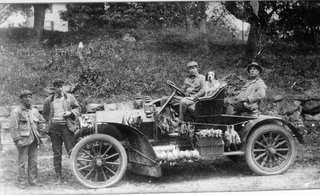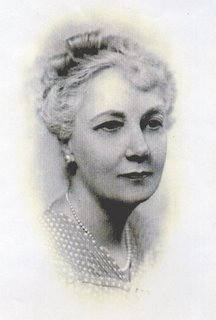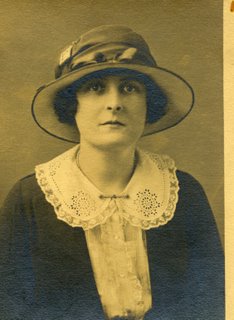 My grandmother, Helen Akin Howell, stayed behind when her husband was in the Caribbean running the sugar business. The family had homes in Connecticut (Winsted), in Southampton, L.I., and in New York City. The estate in Winsted was specifically intended to be a hunting preserve for the family, and the land went across the Connecticut border, into Massachusetts. Their children went back and forth between the locations, often staying with their father in their home in the Dominican Republic. When the financial hard times came, the Howells were forced to sell off Winsted and Southampton, as well as many of their possessions, to make payments on their huge debt and avoid bankruptcy.
My grandmother, Helen Akin Howell, stayed behind when her husband was in the Caribbean running the sugar business. The family had homes in Connecticut (Winsted), in Southampton, L.I., and in New York City. The estate in Winsted was specifically intended to be a hunting preserve for the family, and the land went across the Connecticut border, into Massachusetts. Their children went back and forth between the locations, often staying with their father in their home in the Dominican Republic. When the financial hard times came, the Howells were forced to sell off Winsted and Southampton, as well as many of their possessions, to make payments on their huge debt and avoid bankruptcy.Eventually, as I mentioned in an earlier blog, my grandfather fell in love with his children's Spanish governess, whom he had hired for when he and the children were in the Dominican Republic. Her name was Emelia de Apezteguia, and she was called "Beth". She was the daughter of the late Marquis de Apezteguia of Spain, and the former Helen Vincent, daughter of Dr. Martin R. Vincent of the Union Theological Seminary. She married TAH on April 10, 1918, and was his constant and vibrant companion until his death in 1930.
Meanwhile, back home, my grandmother also fell in love with another man. In fact, she became pregnant by another man before my grandparents eventual divorce became final. In those days (around 1917) this was all a major scandal. My father used to tell me that when the divorce was in process, the children were taken to court and had to choose which parent they would live with. He cried every time he talked about it, even as an old man. I know that it was an emotionally devastating time for him and his siblings.
Both grandparents married their new lovers. Mr. Littell also died before I was born, but my grandmother had two children by him, my father's half-siblings, Elizabeth (Liz) and Emlen Littell. We saw my grandmother occasionally. By then she was living at Quaker Hill, New York, where she had grown up and her Quaker ancestors had founded the community. She was a dignified and somewhat gruff old woman, but beneath her gruffness she was very kind and generous. She was great friends with Edward R. Murrow and his wife Janet, who also lived at Quaker Hill. I remember her taking me to the first movie I ever saw, Peter Pan! Here are two photos, one of Helen, my grandmother, as a young woman, and one when she was older.

 Beth (Emelia), my grandfather's Spanish second wife, after my grandfather died, also married again to Charles Tiffany, Grandfather's former college roommate! Charles Tiffany also died before I was born, but Beth Tiffany was very present in our lives growing up. She lived in New York, hobnobbed with the very rich, and made frequent visits to us on the farm in New Jersey. She always seemed to have a drink in one hand and a cigarette in a long holder in the other. She ate burnt toast, drank thick black coffee, and smoked like a chimney. We always thought she must be black inside! She also had a wry and dark sense of humor and a razor-sharp wit. Beth told hilarious and fanstastical stories, many of them made up, I believe, which delighted us children no end. Here are some photos of her, young and old! Her eccentricity and vibrant personality were some of the highlights of my childhood.
Beth (Emelia), my grandfather's Spanish second wife, after my grandfather died, also married again to Charles Tiffany, Grandfather's former college roommate! Charles Tiffany also died before I was born, but Beth Tiffany was very present in our lives growing up. She lived in New York, hobnobbed with the very rich, and made frequent visits to us on the farm in New Jersey. She always seemed to have a drink in one hand and a cigarette in a long holder in the other. She ate burnt toast, drank thick black coffee, and smoked like a chimney. We always thought she must be black inside! She also had a wry and dark sense of humor and a razor-sharp wit. Beth told hilarious and fanstastical stories, many of them made up, I believe, which delighted us children no end. Here are some photos of her, young and old! Her eccentricity and vibrant personality were some of the highlights of my childhood.

12 comments:
What an interesting family history. This is going to sound off-topic, but I don't think it's too far off. Have you read Mark Kurlansky's Cod: A Biography of the Fish that Changed the World? It touches on some very interesting relationships between the sugar industry, the slave trade, and cod. When you started talking about the various places of cane plantations, it made me wonder if he had any information in the book about those areas. I haven't read it for several years, so the information isn't too fresh, but it may be worth a look.
Lene,
This is a fascinating suggestion. I'm not familiar with this book, but I'll look for it and see if it sheds any light on my elusive grandfather! Even if it doesn't, it sounds fascinating!
Your grandfather was my great-grandfather....I'm Sabina Akin Howell, John Akin Howell's grandaughter. I loved coming across your blog about our family! It's so well written and familiar with the stories my dad and his father used to share with us too.
I hope you are well. Fondly,
Sabina Akin Howell Carr
Atlanta, GA
Sabina,
I'd love to know how to contact you. You can email me directly at the following address:
kimisohapi@yahoo.com
I knew your parents and grandparents and have many happy memories of them!
Kim
Sigrid we are related!!! I was in the process of doing research on Boca Chica for my international law class and I came across your blog. I would love to know where you got all of this information! My grandmother's name is Elizabeth Huntting Howell and I am trying to figure out the exact connection. I do not know much more because my grandmother died before I had a chance to meet her. Is there anything else you can tell me? I would LOVE to know!
Dear Hanna, Your grandmother was my first cousin, and our fathers were brothers. I have photos of your grandmother and her siblings and parents, and know quite a bit about that part of the family. I'm so sorry you didn't meet her. I'd love to share what I have with you. I even have a book on the sugar business that has quite a bit about my grandfather TAH, who owned the sugar plantations down there. The book is called American Sugar Kingdom, by Cesar J. Ayala. It might touch on what you're researching. Sigrid Jardin is, of course, my blogger name. But I am really Kim Tyler (once Kim Howell), and my email address is kimisohapi@gmail.com
I live in California, and would love to talk to you if you want to know more. So nice to hear from you!
Kim
Kim, my name is Robert Larry Akin. I have been working on the history of the Akin family for over 30 years. I have a large family tree on Rootsweb and Ancestry.com. I would love to get your permission to extract and post your commentary "My Howell Grandparents" as a story on my family tree. I would also like permission to copy and post the photos you have on your blog. Another Akin family researcher would like to also post these photos on the FindAGrave website. What do you think?
Hi Robert, Yes, you have my permission to use this information on your genealogy site. Not only that, but I am in possession of a hand-written geneology book presumably kept by my grandmother or great-grandmother that details generations of Akin family links. I've been wondering what to do with this information for some time. It should be used by genealogists somehow. Send me an email ( kimisohapi@yahoo.com) for details. Kim
I would love to be able to email correspond with you about Emelia de Apezteguia. I have been researching her family and her father for some time and am hoping to find some member of her family that may have added information.
Thank you
Harold Tichenor
hltichenor@uniserve.com
"Oblong House"
Quaker Meeting House Built in 1764 Witnessed First
Organized Effort to Abolish Slavery
By EMLEN T. LITTELL of Quaker Hill
This Article Appeared In the November Issue of "The Jeffersonian"
During the early autumn of 1728 a family consisting of father, mother and a one-year old son, equipped with a long rifle, an axe, some simple agricultural implements, and a few articles of crude furniture, started from Oyster Bay, Long Island, by wagon, for a territory in what is now Dutchess County which they had selected. It was on a plateau, six and a half miles long, now known as Quaker Hill.
After many days of hard travel, reached Danbury, Connecticut, where they discovered they could go no further by wagon because of intervening hills. Transferring as many of their belongings as they could to the backs of their horses, they proceeded through the wilderness of their destination, the fertile lands of the "Oblong" eleven hundred feet above sea level, where they erected a crude lodging. On October 18th, 1728, their second son was born, the first white child on Quaker Hill, who caused much interested curiosity among the Algonkian Indians, whose chief at that time was Mawweehoo. The Indians, it seems didn't care much for white neighbors for they decided to move to another country and carried out this idea in the following year, 1729.
Into this beautiful country of Superb hills and rich valleys, came Nathan Birdsall and his wife, Jane Langdon, of Quaker ancestry, as first settlers. The next settler was Benjamin Ferris, the Quaker preacher. It was not until 1731, when the one hundred-year old dispute as to the boundary between the English in New England and the Dutch in New York was settled, that emigration started in any volume, a number Friends coming from Harrisons Purchase, now a part of Rye, in Westchester County, New York.
.........
Hi,sabina...it is so great to read your blog and learn more about your illustrious family.I am Mrs Lalmalsawmi from india,Mizoram.We were penpals some three decades back.would really love to hear from you
Dear Ms. Tyler, My name is Antonio Curet and I am a Curator of the National Museum of the American Indian at the Smithsonian Inst. and where your grandfather's magnificent collection of archaeological objects from Dominican Republic is housed. As part of the efforts to improve our catalog we have been trying to get more information on this collection and the people that were involved in obtaining it. Your blog and the article by T. Anthony Howell in the Collier's have been great help. If possible,could you please either email me (CuretA@SI.edu) or call me at my office (301-238-1365)? I would like to talk to you about this collection and your grandfather archaeological experience and see if you can provide any other information that may be important for future researchers. Thank you very much, Antonio Curet
Post a Comment